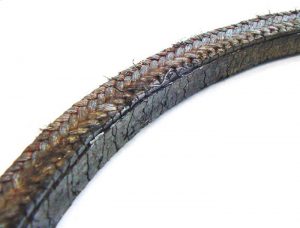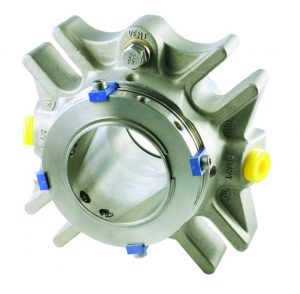Mechanical sealing conserves water, improves energy efficiency, and minimizes environmental impact
The environmental performance of products and processes in all industrial sectors increasingly is cause for critical inspection, with sustainability, conservation of natural resources, and reduced environmental contamination concerns influencing equipment design and selection.
Many industrial processes can be addressed to improve sustainability and minimize environmental impact, while at the same time maintaining or reducing operating costs. Implementing energy-efficient and environmentally friendly processes and technologies should be embraced as a priority at the component, process, and system levels.
One aspect of these processes is mission-critical rotating equipment, and specifically centrifugal pumps, which represent a significant proportion of the equipment found in industrial operations. One vital component of a centrifugal pump is the seal around the rotating shaft that passes through a stationary pressure casing or housing. The seal contains the liquid or gas from escaping to the environment.
Sealing systems help maintain acceptable pump efficiency, reliability, energy consumption, water usage, and emissions control. These factors can materially facilitate achieving total-life cycle cost-reduction and sustainability objectives. Sealing performance can be improved for centrifugal pump applications by upgrading from traditional compression packing to mechanical seal technology.
When sealing a centrifugal pump, the objective is to allow the rotating shaft to enter the wet area of the pump without large volumes of pressurized fluid escaping. The pump discharge pressure forces the fluid back behind the impeller, where it is induced to exit by way of the rotating drive shaft. To minimize leakage, a seal is needed between the shaft and pump housing to contain the pressure of the process being pumped and withstand friction caused by shaft rotation.
Compression packing is the traditional means to seal centrifugal pumps, going back more than 100 years. Also referred to as gland packing, it is a braided, rope-like, and lubricated material packed around the shaft in rings, physically stuffing the gap between the shaft and the pump housing, within a stuffing box.
Water leakage and consumption
 For compression packing to work, some leakage must be maintained to lubricate and cool the packing material. Therefore, packing rings allow for an adjustable, close-clearance leak path parallel to the shaft axis. As the packing is used, however, some of the lubricant that is embedded into the packing is lost, reducing the packing ring’s volume. The pressure squeezing the rings together is also reduced, increasing leakage.
For compression packing to work, some leakage must be maintained to lubricate and cool the packing material. Therefore, packing rings allow for an adjustable, close-clearance leak path parallel to the shaft axis. As the packing is used, however, some of the lubricant that is embedded into the packing is lost, reducing the packing ring’s volume. The pressure squeezing the rings together is also reduced, increasing leakage.
Periodic adjustment of the packing follower brings the pressure back into specification and controls the excess leakage. In today’s world, however, this maintenance is not always being done at required intervals or adjusted correctly. As the number of centrifugal pumps incorporating the use of compression packing decreases, training for and understanding of packing maintenance has waned.
Consequently, under-tightening and over-tightening of packing rings is a prevalent and growing misapplication of centrifugal pump maintenance, with critical consequences to both water consumption and energy draw.
Under-tightening results in too much leakage. Already, when properly adjusted, packing leakage can amount to gallons of liquid leaked per minute. This can be either aqueous solutions comprised of varied benign or caustic chemical compositions, or particles in suspension or slurry, depending on the process.
The heavier the suspension or slurry content in the pumped liquid, the more water is needed to get packing to work reliably. Typically, a clean external flush is piped into the stuffing box through a lantern ring, which keeps the packing lubricated and cool while flushing abrasives and chemicals.
Normally, some portion of the leakage is released continually into the atmosphere. Under-tightening of the packing rings and use of external flushes increase this atmospheric release proportionately, along with environmental impact potential.
Friction and parasitic energy draw
Friction is always present in centrifugal pumps with compression packing, due to the large surface area of the packing rings in contact with the shaft. Over-tightening packing rings restricts leakage flow, increases friction between packing and shaft, and generates excessive heat, which degrades the packing. Increased friction also wears the shaft prematurely.
From an energy consumption perspective, the additional friction of the packing gripping the shaft creates increased drag, requiring more drive power to turn the shaft. It is that drag that leads to additional, significant parasitic energy draw. Thus, the friction-induced energy draw is critical to the energy efficiency of the compression packing.
Moreover, friction is not the only factor influencing energy usage associated with compression packing. When examining the energy draw component of a total life cycle-cost analysis related to compression packing use in centrifugal pumps, another consideration factor is the external flush piped into the stuffing box, as this pressurized water or fluid needs to be moved from a source location to the packing, requiring a pump that draws electricity. Also in some industries where compression packing is more commonly used, water added via the packing flush to maintain a clean environment around the packing needs to be taken out later. Removal of this water requires energy, typically through boiling and via the pump heat soak, with energy transferred from the hot metal of the pump to the fluid within the packing chamber.
These energy draws typically are not measured directly. Instead, current and voltage fluctuations used by the pump motor are assessed under varied operating conditions to determine how much power is being consumed by parasitic influences, which enables packing energy deficiencies to be identified.
 Mechanical seals support efficiency
Mechanical seals support efficiency
The mechanical seal is an alternative to compression packing that resolves many of the sustainability and environmental-impact issues inherent in compression packing. The mechanical seal requires much lower water and energy demand, with substantially reduced leakage, making it more efficient at containing volatile or hazardous fluids, aqueous solutions, and slurry suspensions. In addition, mechanical seals require no maintenance once installed.
A mechanical seal is comprised of a stationary primary element fixed within the pump housing, and a rotating mating element fixed to the shaft. Precisely machined, these two components are pressed together by a flexible load element, meeting at a wear face, while the extreme tolerance precisions between the two elements minimize leakage. The wear faces are supported on an extremely thin lubricating film, typically 0.25 microns (9.8 micro inches) in thickness.
Available in a wide variety of types, arrangements, and materials, mechanical seals are found in most centrifugal pumps today. Advantages include the following:
Minimized water consumption and leakage—mechanical seals require very little flush water to be injected into the seal chamber. Compression packing used in abrasive pumping applications requires significant water volumes to be injected into the stuffing box. A mechanical seal in the same service requires only a small fraction of this water volume.
Seals create an extremely restrictive leak path perpendicular to the axis of the shaft and between the two sliding seal faces. This results in almost no leakage to the atmosphere.
Reduced power consumption—the amount of power required to drive a mechanical seal is as much as 80% less when compared to compression packing, primarily because the seal faces have less frictional energy losses due to the extremely precise mating between the stationary and rotating elements. Additional energy reduction requirements take the form of reduced need for flush water to be pumped into the seal.
Dual mechanical seals—designed to ensure maximum sealing safety, dual mechanical seals are typically defined as a single assembly that contains a pair of seals. A cavity is formed between the two seals within the assembly, which is filled with a barrier or buffer fluid that separates the pumped liquid from the atmosphere and environment.
Dual mechanical seals allow for near complete control over the seal operating environment and the fluid film lubricating the seal faces. They provide maximum elimination of the fluid leakage being handled in centrifugal pumps.
Reduced environmental impact
Efforts made toward improving sustainability in industrial processes, whether by reduced water and energy use, or by eliminating harmful fluid and gas discharge, reduce both environmental impact and operational costs.
Mechanical seals in centrifugal pumps, and particularly dual mechanical seals, are well-suited to reduce or eliminate volatile or hazardous fluids, and their harmful vapors, from escaping into the environment. They should be specified as the standard sealing solution, particularly when the pumped fluids present a safety, health, or environmental hazard.
Original article can be found via the Oil & Gas engineering website, and was written by Mark Savage and Sam Ajram.
Gallagher Fluid Seals is a premier distributor of EagleBurgmann mechanical seals. For more information, contact our engineering department at 1-800-822-4063.
